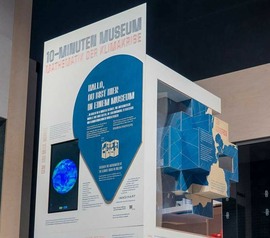10-Minute Museum: Climate Crisis Mathematics
This is a travelling museum you can visit in only 10 minutes. You learn how mathematical models help us understand global warming and predict changes in the climate.
Navier-Stokes equations
programme
Crédits
Contributor: Pavel Dobryakov
Site internet
The movement of balls, cars, and rockets can be explained mathematically. Similarly, the Navier-Stokes equations can explain and predict the movement of fluids, like ocean water, atmosphere gases, an oil spill, smoke, or Currywurstsoße.
We can input the current state of the atmosphere and oceans as numbers in the equations, and get the future weather or climate as the result.
The Navier-Stokes equations have many other applications. They are used to understand airflow around an airplane wing, blood in the circulatory system, and pollution. They also help to simulate fire and smoke in video games.















